|
|
Post by grrraaahhh on May 27, 2012 18:33:12 GMT -9
 Photo credit: Munsey's Lodge, Kodiak, Alaska. An examination of growth and development (including weight) of the Kodiak and Alaska Peninsula Brown Bear. Coming soon to a forum near you.  |
|
|
|
Post by grrraaahhh on Jun 7, 2012 8:15:33 GMT -9
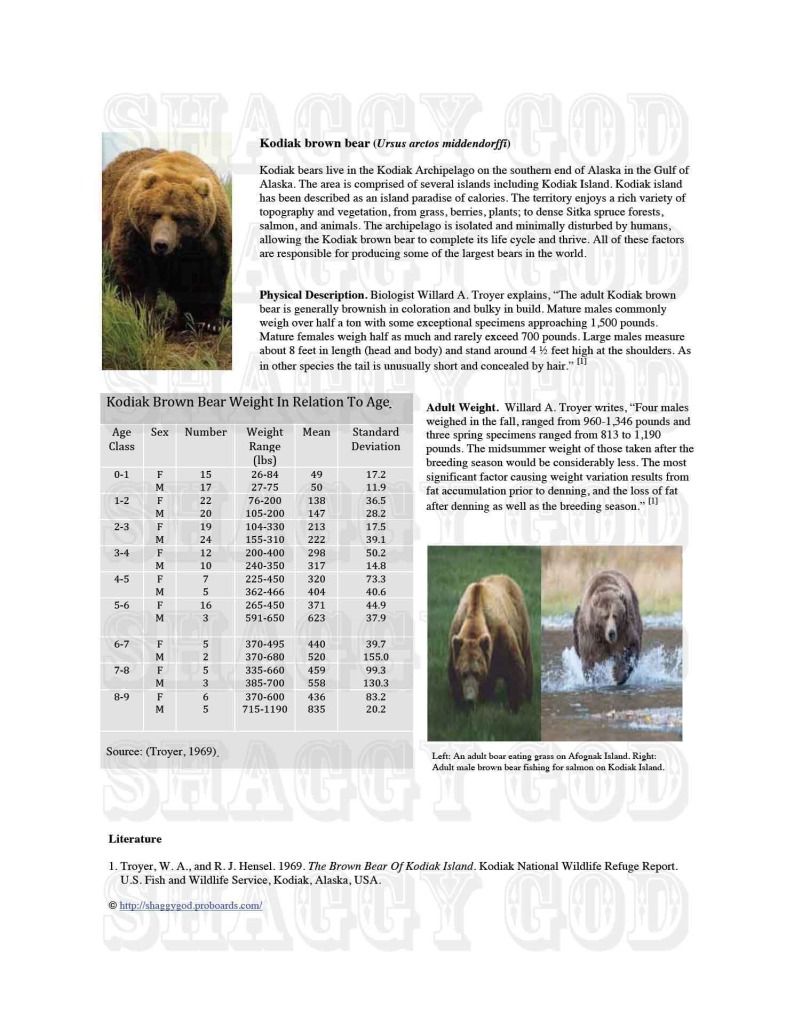 Note: Note: Data were obtained from live-trapped brown bears and to a lesser extent hunting sources collected from 1959-1965. Similar data for the Alaska Peninsula brown bear will be provided shortly. Although we are starting the thread with a focus on weight data, other growth and development information (length, skull, paw measurements, etc) will also be detailed. Overall, a lot of good data (e.g., cubs, sub adults, young adults, mature adults) from numerous sources have been collected. The thread will be unlocked and open to forum member feedback after the data for the Alaska Peninsula brown bear is posted. Thank you for your continued interest and patience. More to come, stay tuned.... |
|
|
|
Post by warsaw on Jun 7, 2012 9:53:15 GMT -9
 Note: Note: Data were obtained from live-trapped brown bears and to a lesser extent hunting sources collected from 1959-1965. Similar data for the Alaska Peninsula brown bear will be provided shortly. Although we are starting the thread with a focus on weight data, other growth and development information (length, skull, paw measurements, etc) will also be detailed. Overall, a lot of good data (e.g., cubs, sub adults, young adults, mature adults) from numerous sources have been collected. The thread will be unlocked and open to forum member feedback after the data for the Alaska Peninsula brown bear is posted. Thank you for your continued interest and patience. More to come, stay tuned.... A quick resume 835 lbs= 378,7 kg for 8-9 y.o. males .Range 324,3 kg - 539,8 kg and record spring weight 1190 lbs = + - 540 kg |
|
|
|
Post by grrraaahhh on Jun 10, 2012 7:38:36 GMT -9
From the Kodiak National Wildlife Refuge web site, "Size range for females is from 400 to 700 pounds and for males 600 to 1,400 pounds. There can be a difference of 20 to 30 percent gain in weight between when they emerge from dens in the spring and when they den up in the late fall." www.fws.gov/refuge/Kodiak/wildlife_and_habitat/bear.htmlAs we examine the data in greater detail, we are better able to chart the growth and development between a young adult bear in comparison to the older mature adult bear. Material Extract "Skull size-age data collected as a result of the regulation changes clearly demonstrated that age structure of the male bear population has a direct impact on the number of large bears available to hunters. On Kodiak, over 90% of male bears have the potential to reach skull sizes exceeding 68 cm, and over half of the bears can attain trophy size if they live long enough. Therefore, when managing for a population that retains a segment of large males, it is important to establish regulations that consider survival rates of adult males as well as productive females. During this study, hunting regulations for Kodiak bears were crafted to distribute harvest throughout the archipelago and reduce hunter efficiency. While season dates included times when hide quality was at its peak, they are also set to afford protection to females that have longer denning periods. Prohibiting harvest of maternal females and their dependent cubs further protected productive females." Van Daele, L.J. 2007. Population dynamics and management of brown bears on Kodiak Island, Alaska. Doctoral dissertation. University of Idaho, Moscow, USA. |
|
|
|
Post by grrraaahhh on Jul 14, 2012 3:57:32 GMT -9
Sorry for the delays everyone. As promised, morphometric data for male Alaska Peninsula brown bear. The data examined covers a lot more material and the document image size is quite large so to make things easier to read, I am providing two links. The first link will fit comfortably into this thread but the text will be too small to read, however, a hyperlink to the full size document is also provided. 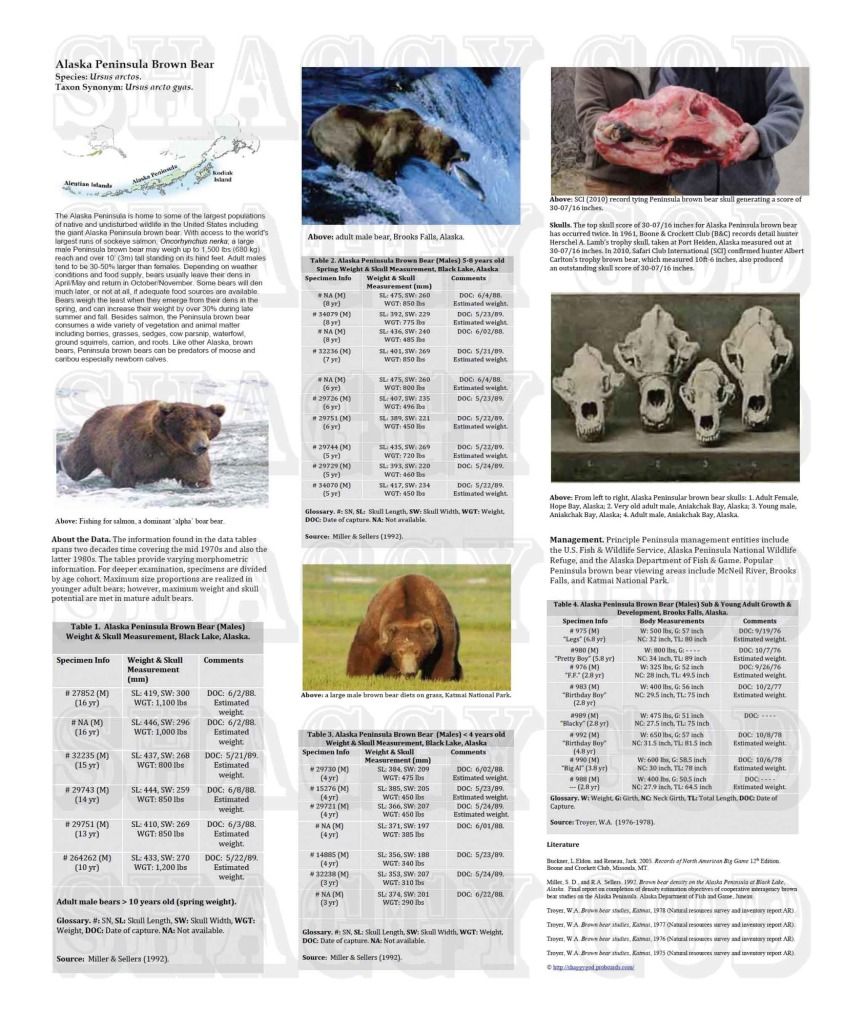 Hyperlink to the full size document: www.easilysharing.com/images/38977914746585274362.jpgNote: From the examined literature, specimen info for all Alaska Peninsula male brown bears over 2.8 years of age is provided. |
|
|
|
Post by grrraaahhh on Jul 14, 2012 4:17:10 GMT -9
Alaska Peninsula brown bear (continued)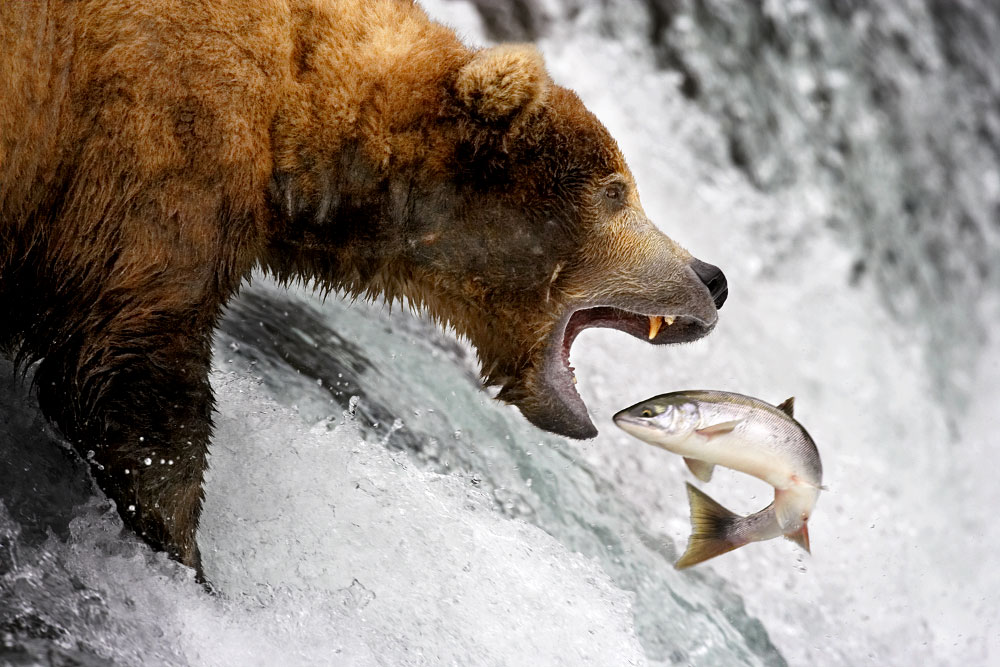 Above. Above. A large male fishes for salmon, Katmai National Park. Material Extract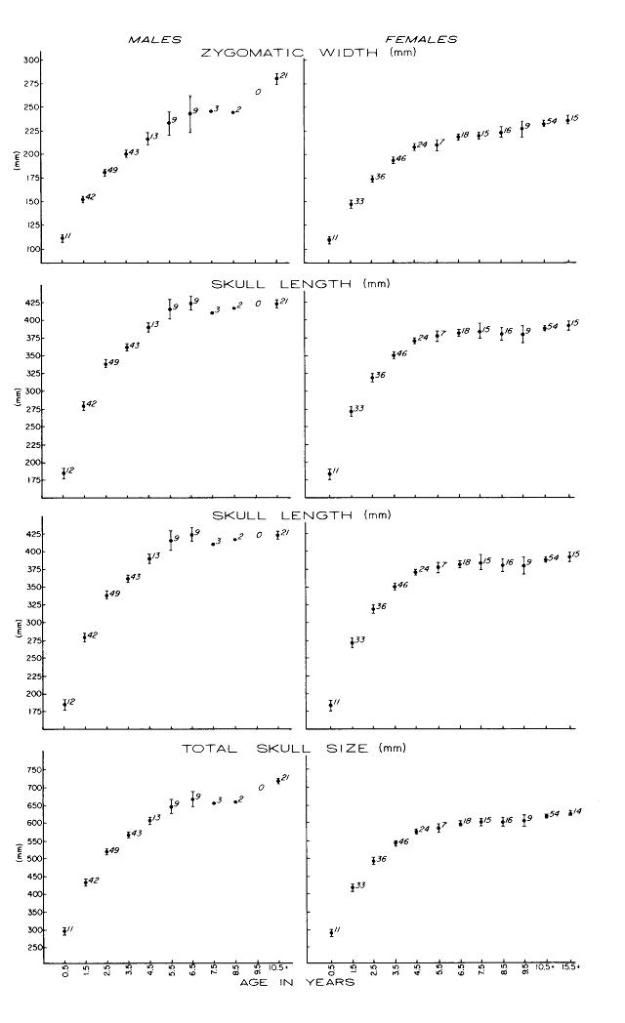 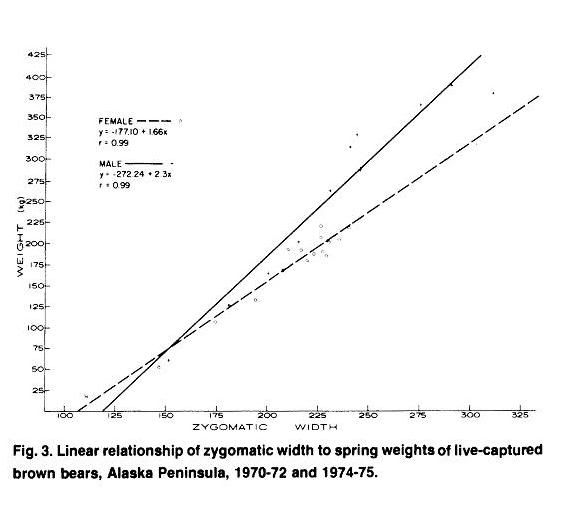 Source: Source: GLENN, L.P. 1980. Morphometric characteristics of brown bears on the central Alaska Peninsula. Int. Conf. Bear Res. Manage. 4: 313 -319.
|
|
|
|
Post by grrraaahhh on Jul 17, 2012 6:47:58 GMT -9
|
|
|
|
Post by grrraaahhh on Jul 17, 2012 6:53:46 GMT -9
Kodiak brown bear (cont) 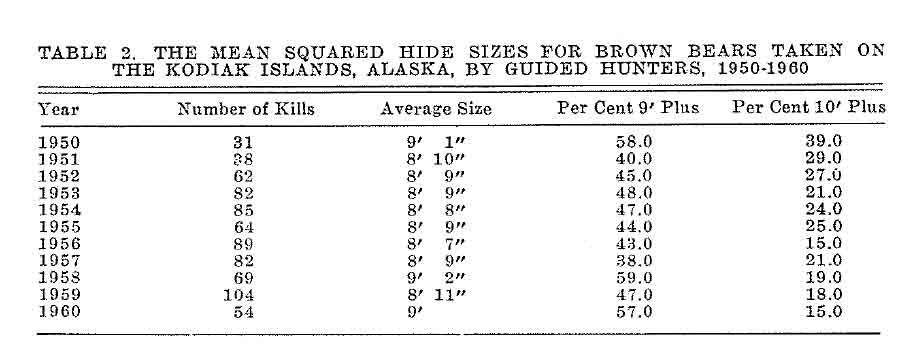 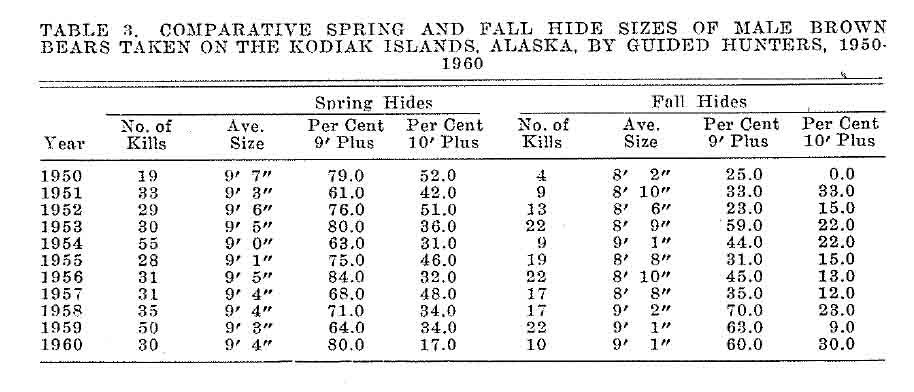 TROYER, W.A. 1961. The brown bear harvest in relation to management on the Kodiak Island. Transactions of the North American Wildlife and Natural Resources Conference. 26:460-468.
|
|
|
|
Post by grrraaahhh on Jul 19, 2012 12:02:36 GMT -9
Material Extract
"Troyer and Hensel (1969) inferred from the available data that brown bears on Kodiak Island lost about 30% of their acquired fall weight while denning. Male bears continued to lose weight rapidly after emergence; however, spring weight losses for mature females and immature bears were less pronounced as they remained in the den longer. The weight lost in spring was usually regained by midsummer. Summer-to-fall weight gains ranged from 110% for cubs to 42% for 5-year-olds. One 3-year-old male gained 20 kg per day and another 3-year-old male gained 1.05 kg/day. Troyer and Hensel (1969) also provided an excellent discussion of fat deposition patterns based on inspection of carcasses."
Source: LeFranc, M.N., Moss, M.B., Patnode, K.A. & Sugg, W.C. (Eds.) 1987: Grizzly bear compendium. - Interagency Grizzly Bear Committee, Washington, D.C., 540 pp.
|
|
|
|
Post by grrraaahhh on Jul 20, 2012 5:49:31 GMT -9
Kodiak brown bear (cont)From the Kodiak National Wildlife Refuge web site, "Size range for females is from 400 to 700 pounds and for males 600 to 1,400 pounds. There can be a difference of 20 to 30 percent gain in weight between when they emerge from dens in the spring and when they den up in the late fall." www.fws.gov/refuge/Kodiak/wildlife_and_habitat/bear.htmlAs we examine the data in greater detail, we are better able to chart the growth and development between a young adult bear in comparison to the older mature adult bear. Material Extract "Skull size-age data collected as a result of the regulation changes clearly demonstrated that age structure of the male bear population has a direct impact on the number of large bears available to hunters. On Kodiak, over 90% of male bears have the potential to reach skull sizes exceeding 68 cm, and over half of the bears can attain trophy size if they live long enough. Therefore, when managing for a population that retains a segment of large males, it is important to establish regulations that consider survival rates of adult males as well as productive females. During this study, hunting regulations for Kodiak bears were crafted to distribute harvest throughout the archipelago and reduce hunter efficiency. While season dates included times when hide quality was at its peak, they are also set to afford protection to females that have longer denning periods. Prohibiting harvest of maternal females and their dependent cubs further protected productive females." Van Daele, L.J. 2007. Population dynamics and management of brown bears on Kodiak Island, Alaska. Doctoral dissertation. University of Idaho, Moscow, USA.  BOONE AND CROCKETT: WORLD'S RECORDS ALASKA BOONE AND CROCKETT: WORLD'S RECORDS ALASKA
BROWN BEAR 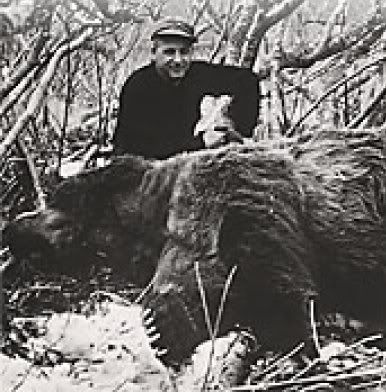 SCORE: 30 12/16 LOCATION: Kodiak Island, AK HUNTER: Roy Lindsley OWNER: Los Angeles Co. Mus. DATE: 1952 KEY MEASUREMENTS: Greatest length of skull without lower jaw: 17 15/16 Greatest width of skull: 12 13/16
|
|
|
|
Post by grrraaahhh on Jul 24, 2012 5:58:48 GMT -9
|
|
|
|
Post by Ursus arctos on Jul 26, 2012 8:55:16 GMT -9
His head looks a little narrow from the front, but it may just be due to his immense width. The head actually looks large relative to body length. Definitely an awesome animal.   From "The Grizzly Sanctuary".  Posted by Warsaw. Interesting to see how the "312 kg" average figure often cited for Kodiak bears brakes down (note that the average weight of the 10 bears in the 6-7 year old and older categories have an average weight of 312 kg). An older, reproductive, male likely weighs substantially more (at least 835 lb). |
|
|
|
Post by grrraaahhh on Jul 27, 2012 5:07:12 GMT -9
RE: 312 kg figure. There are a handful of popular data tables people cite when it comes to North American brown & grizzly bear morphometry including weight. IMO, a comprehensive review of these data tables are called for hence the creation of the following thread. Some of the corresponding data have already been posted (see Extant/North America section) while more will be forthcoming. Getting back to Kodiak brown bears, from the Kodiak National Wildlife Refuge Center, the figure of 600-1,400 lbs for male bears is easier understood. The lower range numbers correspond to young adult male Kodiak bears while the higher numbers correspond to the older mature bears. Regrettably, the data for older "trophy" size bears is thin (in my experience, this is true for many bear populations) where such data can be found would be from hunting literature sources but outside of skull measurements; finding out other morphometrical info (e.g, weight, chest girth, body length, paw size, etc) is challenging. Nonetheless, after reviewing a lot of the technical literature, the quote of the "half-ton" Kodiak bear are common is accurate. Anecdotal observation, when I am watching tourist video (e.g., Youtube) or viewing photograph of mature Kodiak brown bears (less online material) and mature SW Peninsula brown bears (a lot more online sources), I see a lot of males pushing and exceeding half-ton weight & size. |
|
|
|
Post by grrraaahhh on Jul 27, 2012 10:38:58 GMT -9
From the Kodiak Brown Bear Center:
Kodiak bears are the biggest bear in the world?
True. Since we are Kodiak bear biologists, we consider this true- however, in reality it may be a draw with polar bears. The largest bears are measured using three primary criteria: weight, overall length, and skull size.
Adult male Kodiak bears and adult male polar bears reach similar weights, though exact numbers are hard to come by due to the logistics and difficulties of weighing an animal close to a ton in a remote location. The largest male Kodiak bear weighed approximately 1,500 pounds, and this is an often-quoted figure for the largest adult male polar bear as well. We will call this a draw.
In terms of overall length, polar bears likely have a slight edge over an equivalent Kodiak bear because they tend to be more slender and streamlined to aid with their swimming. Kodiak bears are more stocky and robust.
With skull sizes (length + width), Kodiak bears are the clear winners. The largest (living) bears ever recorded have been Kodiak bears, and they even give the largest extinct bears (cave bears and short-faced bears) a run for their money in terms of skull size. The largest polar bear? It comes up on #20 on the list dominated by Kodiaks.
Kodiak bears are the largest terrestrial omnivore in the world?
True. A large male can stand over 10’ tall on its hind legs, 5’ at the shoulder when on all four legs, and weigh as much as 1,500 pounds before hibernation. Adult females are smaller, but can still weigh up to 900 pounds before hibernation.
Polar bears are considered marine mammals because the majority of their lives are spent on sea ice, and thus are excluded from this ranking. Kodiak bears can also be considered the largest terrestrial carnivore in terms of the Order Carnivora (includes wolves, tigers, hyenas, weasels, etc.).
|
|
|
|
Post by grrraaahhh on Jul 27, 2012 10:40:14 GMT -9
Size comparison between Kodiak & Alaska Peninsula Brown BearFrom the Kodiak Brown Bear Center: Kodiak bears are the largest terrestrial omnivore in the world?
True. A large male can stand over 10’ tall on its hind legs, 5’ at the shoulder when on all four legs, and weigh as much as 1,500 pounds before hibernation. Adult females are smaller, but can still weigh up to 900 pounds before hibernation. Polar bears are considered marine mammals because the majority of their lives are spent on sea ice, and thus are excluded from this ranking. Kodiak bears can also be considered the largest terrestrial carnivore in terms of the Order Carnivora (includes wolves, tigers, hyenas, weasels, etc.). “The Kodiak bear’s reputed larger size over that of the nearby Alaska Peninsula brown bear (Ursus arctos gyas Rausch 1953) maybe questionable, however, this belief is somewhat substantiated by current Boone and Crockett Club records which list 12 of the first 13 brown bears trophies as coming from Kodiak Island (Webb et, al., 1958)." Source: Troyer, W.A. 1962. Size,distribution, structure and harvest of a Kodiak bear population. Montana State University. MS Thesis (unpublished). Even today, this observation is true. Kodiak brown bear dominate BCC's top-25 North American brown bear trophy scores. A lot of the morphometric values are close (weight, length, etc) but the Kodiak bear's wider skull gives it the edge against the other North American heavyweight bears which are the Alaskan southwestern Peninsula brown bear and the polar bear.
|
|